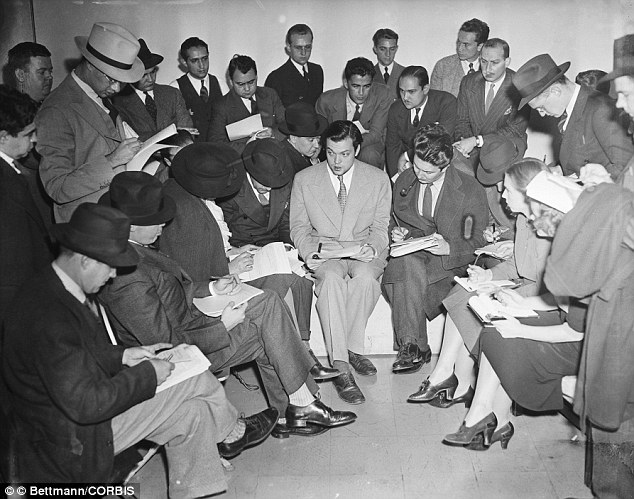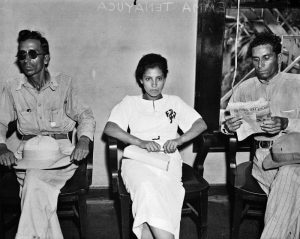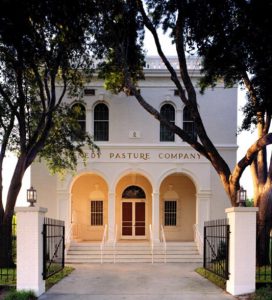Winner of the Fall 2016 StMU History Media Award for
Best Introductory Paragraph
“At least forty people, including six state troopers, lie dead in a field east of Grover’s Mill, New Jersey, their bodies burned and distorted beyond recognition.”1 These were the words heard on the night of October 30, 1938 in homes all over the United States. It was the night before Halloween and the Mercury Theatre on the Air radio show wanted to give listeners a fright in celebration of the upcoming holiday.2 What was meant as a scary story in good fun, sent the listeners of the broadcast into a full blown panic.

The live on air radio production was an adapted story from H.G. Wells’s famous novel, The War of the Worlds. In the novel, the setting takes place in England, and a league of alien spaceships, first thought to be shooting stars and meteors, begin to land. People in the surrounding area grow curious, and decide to venture out and see what all the commotion is. As a man approaches one of the meteors, he realizes it is in fact not a meteor but a hollowed out cylinder. Soon a hatch on the cylinder begins to open and a huge, disgusting creature with long gray tentacles emerges. People begin to flee their homes and panic spreads throughout the town and later throughout England. The aliens attack for weeks, feeding on the blood of humans until finally meeting their deadly fate and falling victim to human bacteria.3

Actor and filmmaker Orson Welles teamed up with one of Mercury Theartre’s writers, Howard Koch to broadcast the show over the CBS radio network. Listeners were enjoying dance music when their program was suddenly interrupted by a report of a meteorite landing. To make the story even more believable, Koch decided to alter the script and changed the location from England to a small village in New Jersey.4 Much of the rest of the story was unchanged and there were “reports” of huge creatures wreaking havoc on the town and killing people with their death rays and poisonous gas. Koch took the story even further and had an actor play the part of a reporter who was live in Time Square and reporting the devastation and destruction of New York City before falling dead himself at the microphone due to an alien attack.5 Another actor on the show who was asked to play an anonymous politician, was able to alter his voice in such a way as to sound almost identical to President Theodore Roosevelt. The “politician” declared a state of emergency and stated that troops were being sent in to help stop the invaders.6

It may seem peculiar that anyone would believe this story as factual, but that is exactly what happened. Koch was careful to make sure there were no commercial interruptions during the program to lend even more authenticity to the special report. There were reports of people all over the East Coast fleeing their homes and some adorned with gas masks remembering that the masks had once been used as a defense against gas warfare in WWI.7 Two geologists from Princeton rushed to the site of the reported meteor landing to get their hands on samples, only to find all was well in the area.8 Radio and newspaper stations were flooded with inquiries about the events reported, demanding to know what was happening. Why would anyone allow themselves to become worked up over a little scary story such as this? To answer that question, one must simply look at the events throughout history prior to and those that transpired during the early 1930s.
The stock market crash of 1929 opened the doors to the Great Depression, which was a time when America saw rates of high unemployment, lower salaries, and increased poverty. In 1937 the German airship, Hindenburg, sailed from Frankfurt, Germany to New Jersey and exploded upon its arrival, killing 36 of its crew and passengers. Between 1934 and 1937, the Midwest experienced a period of drought, loose soil, and high winds resulting in the Dust Bowl, leaving thousands of farmers without crops or livestock for several years. War machines being created in both Germany and Japan caused rising tensions, and people throughout the world were on high alert for a possible attack. The Munich Crisis had recently been broadcast by radio throughout America, and citizens were on alert for invasion.9

Taking into consideration all that had recently transpired in America, one can see why a story of invasion was taken seriously and how it could easily send the country into panic. Sociologist Hadley Cantril said it best when he described the actions of the American people as “anxiety latent in the general population caused by years of economic depression.”10 Even though listeners were told four times during the broadcast that what they were hearing was a dramatization of Wells’s famous novel, the American people were already in such a panic, most did not even hear those words.
Unlike today, news was delivered much slower in the 1930s. People did not have access to social media the way we do today. The War of the Worlds radio broadcast linked Orson Welles to the greatest hoax in the history of broadcasting at the time. If something such as this were to happen in the news today, with the limitless sources to media available, the story would be quickly exposed as the fictional tale it is. The Federal Communications Commission investigated the program, but no laws had been broken and the Mercury Theatre faced no charges. The program had done its job and terrified the American people. At the time the show aired, Americans were still on edge about the possibility of war and this show exposed the fragility of American life.
- Alan Brinkley, American History: Connecting the Past Volume 2, 15 edition (New York: McGraw-Hill Education, 2014), 696-697. ↵
- Funk & Wagnalls New World Encyclopedia, 2016, s.v. “War of the Worlds.” ↵
- Salem Press Encyclopedia of Literature, January 2015, s.v. “The War of the Worlds by H. G. Welles,” by Carl Rollyson. ↵
- Richard Cavendish, “Martians Invade New Jersey,” History Today 58, no. 10 (October 2008): 13. ↵
- Brinkley, American History: Connecting the Past Volume 2, 696-697. ↵
- Richard Cavendish, “Martians Invade New Jersey,” History Today 58, no. 10 (October 2008): 13. ↵
- Brinkley, American History: Connecting the Past Volume 2, 696-697. ↵
- James Naremore, “Who Caused the Mars Panic,” Humanities 24, no. 4 (July 2010): 38-39. ↵
- Salem Press Encycolpedia, January 2016, s.v. “Analysis: On the War of the Worlds Radio Broadcast,” by George Dixon. ↵
- James Naremore, “Who Caused the Mars Panic,” Humanities 24, no. 4 (July 2010): 38-39. ↵



37 comments
Anayeli Prieto
your article was really interesting! the technology that we have invented throughout the years is amazing and the communication that we have is really important because like the article states, a communication tool can save a life if there was a message that needed to get across and there had to be a warning that needed to be sent to the entire village or town or even city. Every day, we evolve in technology and we find new ways for technology that could help us in the present an sin the future.
Briana Bustamante
This was such an interesting article that I new absolutely nothing about. After reading your article, I am well informed about The War of Worlds. I think if I lived in the 1930’s, I too would have reacted the same way. Reading about this incident I think, “wow they really believed that there was an alien invasion?”. Now understanding that during this time so much had happened, and realizing how vulnerable the American life was they had every right to think that way. All in all, your article flowed very well and was explained thoroughly. Love your work!! -your biggest fan <3
Justin Sassman
I admit when my father put the CD version of this story on in his truck one day i believed it too like many of Americans in 1930s. Though hearing the story i never knew much about nor did i know the push that Kosh made to make it even more believable to the listener he went to great lengths to get the prefect radio adaption of the book, almost too prefect some would seeing that many believed it, a very great article and i enjoyed learning about a story from my past.
Erick Martinez
Great intro, the information of H.G. Wells’ novel paves the way for a great article. The in-depth explanation of how Orson Welles brought this story to life intrigues me. I find it very easy to believe that people listening at home would fall for these antics, especially with all the careful planning involved. This article provided a great story as well as a great explanation of what it shows about our society at that given time period.
Nelson Smithwick
I’ve always found the topic of the hysteria caused by the original broadcasting of War of the Worlds to be interesting, and I really enjoyed reading this article. It’s easy to believe people were foolish for believing that the broadcast was real, but these things happen in the form of hoaxes on social media today.
Tina Valdez
I truly enjoyed reading your article. It is difficult to imagine a hoax like this occurring living in modern times. You made a great point at the end of our article – if this had occurred today, it would have been quickly revealed to be a hoax. It must have been quite an experience to hear the broadcast. I find most interesting the entire occurrence of the event, a simple broadcast sending the entire country into panic, wow.
Maalik Stansbury
This was great. The way you explained as to how he would make it into a reality through not interruptions which caused a greater focus on the audience as to what he is saying. I remembering about this as a kid and listening to things like this on the radio. I love how you wrote about this, it’s reminding me of my childhood. You even explained as to where this came from and how he was able to do so.
Mia Diaz
Loved this article! I can remember learning about this story in my middle school history class. Back then I remember thinking, “man how stupid can people get?” Now however, it is quite easy to understand how so many could go into a panic and believe the story to be true. Like you mentioned, the nation had been undergoing many traumas within the past few years, also how the media and newscasts at the time were not as quick as they are now. It is interesting to compare the parallels of the news now to the 1940’s era. Even though the extent of the chaos caused back then is much more drastic to the actions now, people do still get into quite a hysteria over the media’s reports. Given that perspective, it is not hard to imagine why so many people began to go into such a horrible state of panic.
Christian Lozano
Very well written. It was a wonder to many how the American people were terrified of the radio broadcast of H.G. Well’s. But with your presentation and explanation of the history of America in the 20th Century, it is easy to see how the American people would be alarmed by the broadcast, because of their vulnerability at the time.
Trey Whitworth
The way in which Welles tried to make his broadcast as realistic as possible to keep audiences immersed reminded me of what a lot of creators of Internet creepypasta and found-footage films try to do. In fact the crew who worked on The Blair Witch Project actually did something similar to Welles while they were marketing the film, even stating that the movie was “based on a true story.” It’s actually very intriguing.